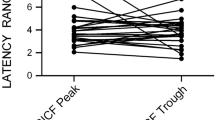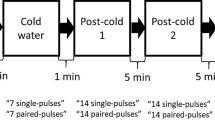Abstract
During the voluntary contraction of target muscles, a silent period is observed immediately after the motor evoked potential (MEP) is elicited by transcranial magnetic stimulation. In this study, the silent period was recorded from bilateral abductor digiti minimi (ADM) and abductor hallucis (AH) in 30 normal healthy subjects (120 extremities) and 30 patients with cervical myelopathy (120 extremities). In normal subjects, the silent period was 142.3±41.0 ms (mean±SD) for ADM, and 83.6±42.3 ms for AH. When stimulus intensity was increased from 60% to 95%, the length of the silent period increased, reaching almost maximal level. The length of the silent period correlated with stimulus intensity, but not with the contraction force of voluntary muscles. In patients with cervical myelopathy, the silent period was 69.2±27.8 ms (mean±SD) for ADM and 48.3±17.0 ms for AH, significantly shorter than in the normal subjects. We believe that the length of the silent period can be a useful parameter for indicating the function of the spinal inhibitory system.
Similar content being viewed by others
References
Barker AT, Freeston IL, Jalinous R, et al. Magnetic stimulation of the human brain. J Physiol 1985;369:3.
Delwaide PJ. Human monosynaptic reflexes and presynaptic inhibition. In: Desmedt JE, editor. New developments in electromyography and clinical neurophysiology. vol. 3. Karger: Basel, 1973:508–22.
Eisen A, Siejka S, Schulzer M, et al. Age-dependent decline in motor evoked potential (MEP) amplitude: With a comment on changes in Parkinson's disease. Electroenceph Clin Neurophysiol 1991;81:209–15.
Higgins DC, Lieberman JS. The muscle silent period: Variability in normal man. Electroenceph Clin Neurophysiol 1968;24:176–82.
Hoffmann P. Demonstration eines Hemmungsreflexes im menschlichen Rückenmark. Zeitschrift für Biologie 1919;70:515–24.
Iizuka T, Azuma H, Tanaka H et al. Magnetic transcutaneous stimulation of the motor pathway in spinal cord disorders. In: Shimoji K, Kurokawa T, Tamaki T, Willis WD Jr, editors. Spinal cord monitoring and electrodiagnosis. Berlin Heidelberg, New York Tokyo: Springer, 1991:253–61.
Iizuka T, Iida S, Imai T, et al. Evaluation of motor pathways in patients with cervical myelopathy by magnetic stimulation: Pre-, intra-, and postoperative study. In: Jones SJ, Boyd S, Hetreed M, Smith NJ, editors. Handbook of spinal cord monitoring. London: Kluwer Academic, 1994:294–300.
Kamekyama O, Hayes KC, Wolfe D. Methodological considerations contributing to variability of the quadriceps H reflex. Am J Phys Med Rehabil 1989;68:277–82.
Kimura J. Recurrent inhibition of motoneurons during the silent period in man. In: Desmedt JE, editor. Motor control mechanisms in health and disease. New York: Raven, 1983:459–65.
Lance JW, Gillies JD. Presynaptic inhibition induced by vibration. Jpn J EEG EMG 1973;2:5–11.
Merton PA. The silent period in a muscle of the human hand. J Physiol 1951;114:183–98.
Shahani BT, Young RR. Studies of the normal human silent period. In: Desmedt JE, editor. New developments in electromyography and clinical neurophysiology. vol. 3. Karger, Basel, 1973:589–602.
Tanaka R. The role of inhibition to human motor control (in Japanese). Rinsho Seikei Geka (Clin Orthop Surg) 1990;25:1049–55.
Uozumi T, Ito Y, Tsuji S, et al. Inhibitory period following motor potentials evoked by magnetic cortical stimulation. Electroenceph Clin Neurophysiol 1992;85:273–9.
Author information
Authors and Affiliations
About this article
Cite this article
Suyama, N., Shindo, H. & Iizuka, T. Study of the silent period following motor evoked potential by magnetic stimulation method. J Orthop Sci 1, 301–306 (1996). https://doi.org/10.1007/BF02348839
Received:
Accepted:
Issue Date:
DOI: https://doi.org/10.1007/BF02348839




